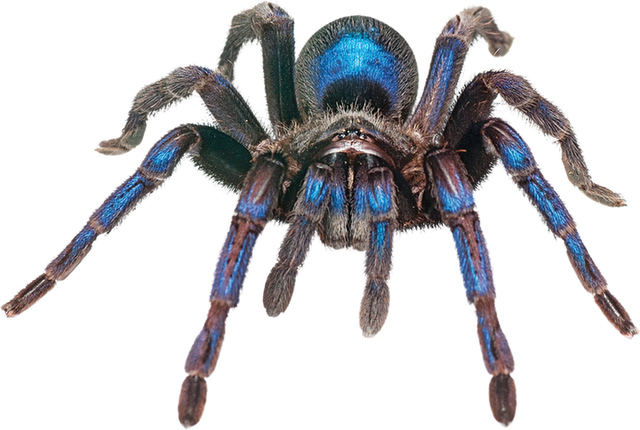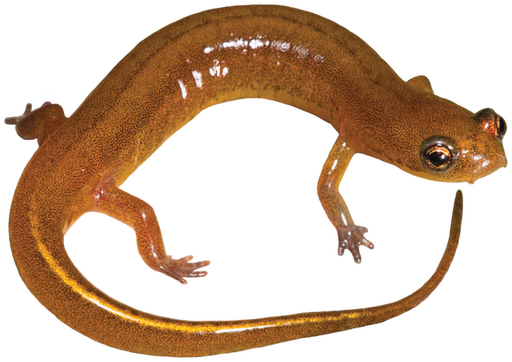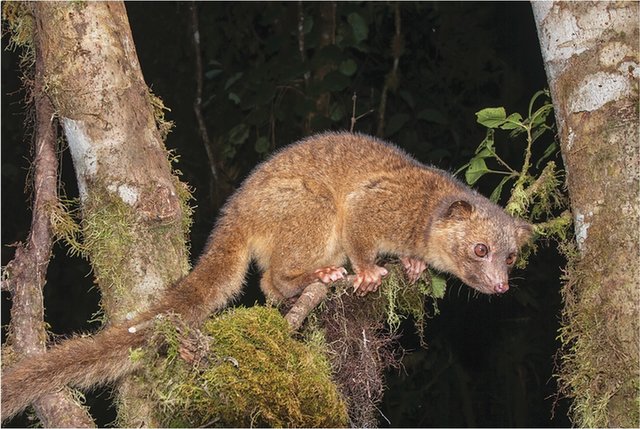

hairyblue tarantula
NewandBlue
Everyyear,approximately18,000 newspeciesarediscovered.Thatmeansscientistsworldwideareencounteringupto50newspeciesevery day.
ScientistAndrewSnydercouldn’tseeathingashestumbledalongtheforestfloor.DarknessbathedthebranchesoftheGuyanarainforest,whichthenewmoon’slightcouldnotpenetrate.Therainforestwas alive.Unseenrustles,clicks,andscreamsfilledthenight.Snyderturnedonhisflashlightandsawabrilliantflashofblue.Hefixedthebeamon arottingstumpandfocusedontheblue.Thestumpwascrawlingwithadozenhuge,bluespiders.Hewaslookingatanever‑before‑seenspecies:hairyblue tarantulas!
Youmightthinkthattheworld’snewdiscoverieswouldbemostlymicrobesandinsects.Theyarebeingdiscoveredallthetime.Butthey’renottheonlythingsoutthere.Big,colorful,andevendazzlingnewspeciesseemtobeturningupeverywherethese days.


patch‑nosed salamander
HidinginPlain Sight
Somenewspeciesarerightunderournoses.AscientistattheRoyalBotanicGardensinLondon,forexample,discoveredthreeunknownspeciesoffungusinapackageofdriedmushroomsfromthegrocery store.
Thepatch‑nosedsalamanderwasdiscoverednearacreekinGeorgiain2007,andtheAtlanticCoastleopardfrogwasfirstidentifiedonStatenIsland,NewYork,in 2008.
WhyNow?
Morespeciesarebeingdiscoverednowbecausemorescientistsarelookingattheworldindifferent ways.
Humansaremakingmoreroadsandcuttingdownforests.Theyareexpandingintowildplacesthathaveneverbeforebeenexplored.Scientistsarepayingattentiontohowthesewildplacesarechanging,andtheyarecomingacrossnewspeciesthathaveneverbeenseen before.
Scientistsareusingnew,moderntoolslikeremote‑controlsubmersiblesanddeep‑seacameras.Theseallowexplorerstosearchtheworld’sextremenooksandcranniesthatwereonceimpossibletoreach.NewspeciesliketheIndonesianpsychedelicfrogfish,theyeticrab,andthesix‑gilledsharkhaveemergedfromthe depths.

Indonesianpsychedelic frogfish
Mismatch
SometimesanewspeciescanbefoundbylookingatDNA.ScientistsattheNationalZooinWashington,D.C.,werefrustratedbyapairoftheirresidentolinguitos.Theseraccoon‑likecreatureswerenotproducing offspring.
Aftertestsweredonetoseewhattheproblemwas,theylookedattheanimals’DNA.Itturnsoutthatthetwoanimalswerenotthesamespecies!Onewasanolinguitoandtheotherturnedouttobeacompletelydifferentspeciescalledan olingo.

olingo

olinguito